Is private property a barrier to food system transformation?
Most of us know that the modern, industrial food system is failing. It is inadequate to the task of meeting the nutritional, cultural and sustenance needs of most people around the world. Although it has been credited by some with a historically unprecedented expansion in agricultural yields, it is also increasingly acknowledged to cause significant climactic, ecological, social, health-related and economic harms. Agroecology, on the other hand, has been shown to address many of those issues, while creating thriving ecosystems and societies, both rural and urban.
Agroecology is grounded in traditional ecological farming practices, as well as those findings of modern science and agricultural practice that enhance ecosystems. While in some of its more mainstream variants, agroecology is understood as a purely technical solution to the technical problems of the food system, this is a deviation from a more expansive understanding of agroecology. This approach, which some people might call ‘radical’ or ‘political’ agroecology, is grounded in principles of collective governance and equity, and recognises that an agroecological transition will require deep economic and political transformation. Radical agroecology is closely connected with food sovereignty — an idea popularised by the international peasant organisation, La Vía Campesina, which, broadly speaking, refers to the right of peoples to have control over their food systems.
But what does this have to do with property? I think that if we accept the radical agroecological position, then (as I’ll elaborate below) it starts to become possible to argue that a system of property dominated by private landownership — like the one we have today in places like the UK, the US, Aotearoa New Zealand and much of Europe — poses a barrier an agroecological transition.
This is not an uncontroversial statement, and there are many people who do a great deal of admirable and important work to pursue an agroecological, and a generally fairer and more sustainable, food future within the existing property regime. However, I think that it’s worth thinking more critically about property — I think it might help to understand a key roadblock (though by no means the only one) to making those futures real.

There are many reasons why you might argue that private property and agroecological food systems don’t mix. For example, a key feature of private property as we understand it today is alienability — that is, the right to sell your land. Implied by this right is the existence of markets upon which the land can be sold. Those markets create a situation in which the distribution of rights depends on purchasing power, not need; this, in turn, tends to drive up the cost of land, excluding potential new farmers from accessing it on the basis of class, wealth, race, gender, and a myriad of other intersecting factors.
Through the same mechanism, land markets favour large, often institutional, investors in land, driving the concentration of large tracts of land in the hands of investors who desire it for its exchange value — that is, its ability to produce a profit (for example, as a form of natural capital, or through the production of carbon offset credits). This excludes those who would otherwise claim the land for its ‘use value’: its ability to provide shelter and produce food, or its cultural and social significance. This exclusion of new entrants and aspiring agroecologists at the expense of large, often corporate, landowners will be familiar to anyone who has spent any time with sustainable food movements. The key here, though, is that these dynamics are not a ‘bug’ that can be adequately resolved through better or ‘free-er’ (or ‘friendlier’) markets, but a central feature of the system of private property.
Private property also gives huge power to landowners to make decisions about what is done on their land — that’s why some people call it the ‘castle and moat’ model of land relations. Regulation can limit this dynamic to some extent — for instance through the planning system — but there is only so far it can go. Of course, many private landowners can and do choose to farm agroecologically, and many of the most inspiring, hopeful examples of agroecological practice can be found on such privately owned farms. But the point is, within the private ownership model, there isn’t much of anything to stop someone from choosing otherwise. This creates a hurdle to scaling up and systematizing an agroecological food system transition, especially at the rate needed to address urgent crises like climate change, biodiversity collapse, and deep social injustices.
Yet all of this lies beneath the surface. Private property is sort of like the air we breathe. We often don’t think about it until someone points out that it’s there.

Back in the 1800s, Karl Marx claimed that capitalism was founded on what he called ‘primitive’ or original accumulation. The enclosure of the English commons is often given as the archetypal example of this process. David Harvey later argued that this wasn’t just original, but ongoing — what he called “accumulation by dispossession”. Through such acts of dispossession, land and other social goods that had existed outside the capitalist market are brought inside of it, in order to support the production of profit. Importantly, this process of accumulation was, and continues to be, carried out through (often imperial and colonial) coercion, violence and — crucially — the law.
Over the past several centuries, the law has enabled the creation of a system of private property where land is understood as the object of a property relationship, wherein it is owned by human subjects. It has been used to transform assets into capital by imbuing them with particular properties like priority, durability, universality and convertibility, making them amenable to be used as tools for the accumulation of wealth. And, thanks to the centrality of private property in well-functioning capitalist markets, it has facilitated the creation of a system of rights in which the right to property tends to trump other rights, like health, or a clean environment.
But the complicity of the law goes deeper. Drawing on the work of a wide range of indigenous thinkers, Robert Nichols argues that private property is actually created through theft. He shows how, in the United States, occupations by settlers of sovereign indigenous territory beyond the Western-most borders of what was then the United States were initially deemed ‘illegal’ by the settler government. But these illegal squatters were then retroactively transformed into property owners once they could prove that they had ‘improved’ the land by working it, thus dispossessing the former indigenous residents and expanding the territorial boundaries of the settler state.
In Aotearoa New Zealand, this kind of analysis might be able to be applied to cases like Wi Parata v Bishop of Wellington [1877]. In this case, local iwi Ngāti Toa had given a piece of land to the local Anglican church on the condition that a school be built on it for their children to attend. A school was never built, but the Crown nonetheless issued a grant in the land to the church, without the consent of the iwi. Wiremu (Wi) Parata, a Ngāti Toa farmer and politician brought a case against the church to get the land back, but Chief Justice Prendergast was unmoved.
In a now infamous judgment, Prendergast ruled that the Treaty of Waitangi — signed between (some) Māori and the British Crown in 1840 and considered by many today to be a key constitutional document — was a “simple nullity”. He claimed that Māori were legally incapable of signing the Treaty, meaning that it had never been valid in the first place. And even if it had been valid, it had never been incorporated into domestic law and so could not have any legal standing. In effect, this retroactively gave legal legitimacy to the theft by the church and Crown of Ngāti Toa’s land, and in doing so transformed it into private property.
Overall, what this brief discussion begins to show is that the regime of private property in land is deeply shaped, perhaps inextricably so, by the interlinked forces of colonial capitalism and the law. This goes beyond purely functional explanations of incompatibility with agroecology to reveal its roots in dispossession, exploitation, and oppression — and thus its normative incompatibility, too.

As this regime of property and the colonial capitalist system of which it is a cornerstone has come to dominate all corners of the globe, it has become increasingly hard to imagine other ways of relating to the land. Private ownership has a firm hold on how we think about and imagine the land and our relationship to it.
For example, research has found that nearly 70% of aspiring farmers in British Columbia ranked private ownership as their ideal type of land arrangement. This imaginative limitation might be termed ontological policing, meaning that it draws strict boundaries around what does, and doesn’t, count as property. Anything beyond those boundaries is made to seem unnatural, unrealistic or unworkable — a leftover from an earlier, less developed time or a hopelessly naïve utopian yearning.
So, does this mean an agroecological transition is doomed? Not in the slightest, because, of course, there are many other ways of relating to land beyond the strict confines of private property. One alternative can be found in the theory — and practice — of the commons, most famously developed by Elinor Ostrom in 1990. Ostrom showed that sustainable community management of resources was entirely possible under certain conditions or ‘design principles’. More radical understandings of the commons go beyond Ostrom’s functionalist understanding to distinguish between capitalist and anti-capitalist commons and to argue explicitly in favour of practices of commoning that seek to undo the exploitative dynamics of oppression that stifle human and non-human health and flourishing. Community landownership might in some cases be one example of such commoning practice.
Another, perhaps related, alternative is to treat land not as property at all, but rather as a relation, as kin, as something that we belong to, rather than belonging to us. As Krueckeberg put it, “What we own we cannot sell. And what we sell we do not own.” Of course, this is not a new idea, but in fact a core element of many indigenous and traditional worldviews from all around the world (see e.g. here and here). In rejecting the commodification and enclosure of land as property, these two alternative land regimes may present possible resolutions to the question of land in a post-capitalist agroecological transition.
The law of property, despite the vast power it wields, is ultimately a social construction. It is made by individuals and socially legitimised through recognition and acknowledgement. And just as it has created, legitimised and upheld a regime of private property, so too can it support the development of alternative land relations. These kinds of legal innovations and contestations are, in some parts of the Global North, already establishing or enabling community ownership and stewardship of land.
From my very early review, I would tentatively suggest that there are four different approaches to or engagements with the law of property that can be identified in this regard:
- Legal reforms establishing or supporting community ownership — like what has been seen in Scotland (although it’s important to note that very few explicit connections have been made at a policy level regarding the relationship between these reforms and the food system).
- The establishment of community land ownership within already existing legal structures — we can see this in places like England (e.g. the Ecological Land Cooperative), the United States (e.g. the Agrarian Trust), and elsewhere.
- The revitalisation, in some settler-colonial states, of indigenous land laws and relations, either in spite of, or with limited/limiting support from, the laws of the colonial state.
- Active opposition to dominant property laws and norms through interventions like squatting and occupations. We can see this in indigenous land reclamation or Landback occupations — such as the occupation at Ihumātao. It’s also evident in places like Andalucía, Spain, where a local agricultural labour union has occupied land owned by the local municipality and, rather than accepting an offer of ownership of the land, has called instead for land nationalisation.

Ultimately, what I hope this begins to show is that:
a) Private property is not necessarily desirable as a basis for the land system or the food system;
b) This is particularly the case if we are to build agroecological futures in the radical sense of the word — serving ecological and social, economic and political aims;
c) The modern regime of property dominated by private ownership is constructed upon colonial capitalist foundation and is rooted in dispossession, exploitation and oppression;
d) But it doesn’t have to be this way — radical alternatives are possible.








